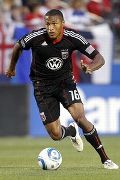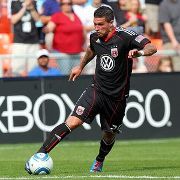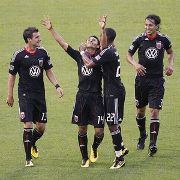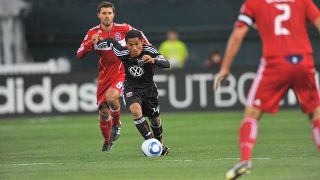WASHINGTON -- Andy Najar, 17, runs cuts and curls, darts off and comes to a sudden stop. He drifts to the right wing, collects the ball with his right foot, controls it with his left and flips it into space with his right again, sending D.C. United teammate Adam Cristman on a clear path to goal. Three touches. Cristman only has to tap the ball over the goalkeeper to put his team ahead.
Najar whizzes past a man and sends in a dangerous cross.
He chests a ball down, deadens it off his right quad and plays it off his left foot before it hits the ground. Next, he hurtles off in pursuit of a loose ball. The defender gets there first, but Najar hounds him into giving up a throw-in.
Minutes later, Ugo Ihemelu, an experienced defender for FC Dallas, holds the ball securely between his feet. Unnoticed, Najar comes up from behind him and rolls the ball back from in between the unsuspecting Ihemelu's legs and immediately plays it back to a teammate in scoring position.
Najar covers acres of space, sneaking into vacant pockets, hugging the offside trap, dropping deep to collect the ball. He sends crosses, through-balls, high balls and back-passes. All arrive.
He peels off a long dribble toward goal. When he is upended, Cristman gets a good chance to score. A feisty shot from distance is deflected for a corner.
Najar fakes out his defender and spurts off. He meets a cross from Cristman by the second post, slipping his foot under the ball just before it lands on the turf, swatting it into the net with the outside of his right foot with a sense of finesse laughing in the face of his youth. His first professional goal. One touch.
On the next play he gets another cross from Cristman, to his head this time. He pounds it toward the grass but sees Kevin Hartman make a fine save.
With minutes to spare, Najar is still pressing, still running hard, his eternal thirst for the ball unquenched.
When the game is over, Najar appears on the big screen: "Andy Najar, D.C. United, Man of the Match."
He has led D.C. United to its first win of the year.
And on this day, he did so showing off some of the technical ability and imagination that made Freddy Adu such a scintillating talent. Only Najar combines it with moxie and a monstrous appetite for on-field labor, something conspicuously absent from Adu's game when he ambled around this very stadium.
Andy Najar is the bright lining to the very dark cloud over D.C. United's start to the season. He's also the poster boy for the future of youth soccer in the United States.
In 2001, five years into its existence, D.C. United became one of the first MLS teams to dabble in youth development, launching a team for players under the age of 15 (U-15). It immediately won a national championship in its age bracket. "That was the beginning of our youth development system," says Curt Onalfo, now United's head coach but then an assistant coach charged with the creation of a youth team.
The vision of a full-blown youth academy had been born from a realization that the areas abutting Washington were abundant in young soccer talent. "It's a hotbed here in D.C.," says Onalfo. "It was just a matter of getting them the right training and the right coaching."
The program now fields teams in four age brackets and operates on a $500,000 annual budget, a sizable sum in a league where payrolls are capped at $2.55 million. After three years of play, the U-16s have won two national championships and finished second once. The U-18s were national finalists last year.
In 2006, Najar, a slight 13-year-old recent immigrant from Honduras, first tried out for the academy, which weeds out 75 percent of applicants. He was turned away, deemed too young.
He enrolled at Edison High School in Alexandria, Va., in the summer of 2007, and an assistant soccer coach noticed him playing pickup games in front of the school. "One of the best kids I've ever had fell into my lap," recalls head coach Scott Racek. "He would still be playing out front if it weren't for my assistant."
In his high school debut Najar scored a hat trick. "That was the first time he stepped on the field, I think, in organized soccer," says Racek. Before his freshman year was out, Najar returned to United and made the cut.
Splitting time between United's under-16s, under-18s and Edison as a sophomore, Najar scored 22 goals in just 14 games for the latter, earning Washington Post All-Met First Team honors.
Najar dropped out of Edison in the spring of 2010 (D.C. has since taken charge of his education) and signed a guaranteed contract with United on March 22 worth at least $40,000 annually through 2011 and climbing up to at least $50,000 per year if club options are picked up through 2014. Najar joined goalkeeper Bill Hamid as United academy players to be picked up by the senior team.
The young midfielder made his debut in the season opener, a 4-0 loss at Kansas City. Benefiting from a spate of injuries and the transient lineup of a team desperately seeking points and form, Najar made two more MLS starts before he was slowed by an ankle injury. He returned to the starting lineup on May 28 against Chivas USA, scoring his first MLS regular-season goal and picking up another man-of-the-match nod.
In just a couple months, Najar has left a deep impression.
"I love the kid," says United assistant coach Ben Olsen. "He's just such a breath of fresh air -- when a 17-year-old kid can be out there with grown men and be inspiring in the way he plays. He's a kid who every time he's on the field is going to be a little warrior. It's a rare thing and I'm glad we have him."
United goalkeeper Troy Perkins laughs, "I don't know where he came from. He's only 17 and he plays like he's 22, 23 years old. He's got grit, he's got the toughness and he's quick and creative and he's going to be a fantastic player.
"Some people would say it's one off, that they found that lucky star," posits Perkins. "But let's look at the bigger picture. We've got Bill Hamid, who is 19 years old and is a fantastic prospect as a goalkeeper as well." Hamid became the youngest goalie to win an MLS game in his very serviceable pro debut on May 5 and hasn't relinquished the starting job since. "I think it gives a huge amount of respect to the academy," Perkins says.
* * * * *
D.C. United president Kevin Payne, who chairs a U.S. Soccer task force on player development, refers to the academy approach as an "intervention."
"A lot of research showed that a lot of the best young soccer players in America were playing way too many games -- in many instances over 100 a year -- and way too many of those games were not of very high quality," he says. "We had our ratio of training time to games inverted to the rest of the world. Countries that are really great at developing players routinely try to establish an average of four- or five-to-one ratio of training time to game time. And we were the opposite. We had to turn that on its head."
In its zeal to create better soccer prospects, the youth soccer community in the U.S. had crammed more and more games and tournaments into tight schedules, leaving little time for the necessary repetitions that might not come in a game but that are fundamental to the pursuit of professional-grade skills. Youth soccer, the task force decided, had to be brought back to basics: lots of practice interspersed with a few good games against quality opposition.
"It's not a secret how great achievers in every sport reach that level," explains Payne. "There's almost a formula in how much high-quality training is needed to achieve real excellence. The environment our young players were in made it impossible to approach that."
So the U.S. Soccer Development Academy was born, and it created the Academy League, an elite league for both MLS academy teams and traditional youth club teams that met the requirements for practice time.
The approach was different. The final score and the standings would be subservient to the development of skills and technique. Teams had to stop chasing after pennants and tournament wins.
"When you emphasize winning as the be-all, end-all, that doesn't necessarily foster decisions in the best interest of the player," says Todd Durbin, an executive vice president for Major League Soccer. "You want him to learn the game and part of that is going to be to make mistakes. Winning is important but it's not primary."
In 2007, MLS made it mandatory for its franchises to establish a youth development program with at least two teams and a full-time coaching staff. Youth players could come from anywhere within a 75-mile radius of the senior team's stadium, and each youth team could carry two additional players from outside of that zone, so long as he didn't live in another team's market. As an added incentive, MLS offered clubs the option to sign its "homegrown" products without going through the SuperDraft.
Some MLS academies field teams in as many as six different age brackets. Except for Toronto FC, whose youth teams play in a Canadian semipro league, all 12 full MLS academies field Academy League teams. Some even have residency programs. The Colorado Rapids went as far as building their own grassroots leagues for children ages 5 through 18, which now encompasses more than 17,000 players, according to the club.
The four remaining teams without a full academy -- three of which are recent expansion teams -- are either in the process of recruiting and building their academies or already operate part-time teams that play in the summer months or merely complement the training and games their kids are getting with their club teams. All intend to eventually enter the Academy League and operate complete programs.
The convergence of talent in the Academy League has rapidly improved the quality of play, according to insiders.

"The tempo and the level of training is a lot higher than normal [youth] training sessions," says Urbano Castro Jr., United's youth development coordinator. "We've had guys that came out from top-notch regional teams and they'll step into our training and they'll kind of struggle just because it's faster, more physical."
Iyassu Bekele, a 17-year-old striker for United's U-18 team, agrees. "I was at [an elite local youth club] before I came to this team," he says. "But it wasn't as competitive as it is over here."
Najar adds, "In the academy I learned about tactics and how to defend better as part of a team. I wasn't used to playing the physical style of the game here prior to coming to the academy. It also helped me develop my skill with the ball."
While the academies have yielded eight homegrown players to their parent MLS teams, the formula isn't yet perfect, as a large gap looms between the Academy League and Major League Soccer, one that not all players can bridge, leaving them in danger of missing out on the competitive minutes needed for their development. But plans for bringing back an MLS reserve league are in the works.
The benefits to being brought up in-house by a pro team are many. "The players get exposed to pro culture," says Payne. Any D.C. United academy player can walk into RFK for free on game days. They're encouraged to attend as many games as possible, to come down to the field to watch warm-ups, to come see the locker room and get a feel for the atmosphere. This spring, the Chicago Fire brought their entire U-18 and U-16 teams to Guadalajara, Mexico, and Jackson, Miss., respectively, during their season preparations.
What's more, young teenagers don't have to be uprooted to pursue their professional aspirations. Santino Quaranta, a United winger from Baltimore, shipped off to the U.S. U-17 residency program in Florida, before turning pro at 16. "We had to go off to Bradenton and other places," Quaranta, now 25, says of his generation of prospects. "It's great to be able to stay at home, at your own high school here and train with the professionals."
Claudio Reyna, the former U.S. national team captain recently appointed as U.S. Soccer youth technical director, says it's problematic for kids to frequently switch youth club and travel teams, and change high schools, all to further their soccer careers. "That turnover needs to calm down a little bit," says Reyna. "It's better for the development of a kid if they're at one place in the same sort of comfortable environment, rather than move around."
Another chief pitfall of elite American youth club soccer is its prohibitive cost. Known as "pay-to-play," some programs can cost five figures per child per year. Many prospects from disadvantaged backgrounds are thought to be scared off by the towering fees, which can cause some talent to slip through the cracks. That's why MLS endeavors to keep academy costs to parents at a minimum.
Of the MLS academies that already exist, 10 are completely free. Only D.C. United charges a flat fee -- $1,000 a year, which includes everything -- and United does offer scholarships. Two teams do charge for some travel costs.

Ultimately, MLS hopes to get all academies to become completely free. "We're evolving towards that," says Durbin. "The long-term goal is that our academies are not pay-to-play. We want to make sure players are selected purely on their ability and not their ability to pay."
Bekele, who hails from Ethiopia, pays nothing to play for United's U-18s. Najar says, "My parents didn't have the income or the resources to pay that kind of money for me to play for a [youth] club. It would have been very difficult."
Had Najar, who paid the flat fee at United, been unable to play for any other team than his high school, chances are his entry into the pro ranks would have been delayed by several years. Without the academy, he would most likely have honored his plan of finishing high school and playing a year or two in college before declaring for the MLS SuperDraft.
MLS teams can use two roster spots that don't count toward roster limitations on academy graduates. "It's nice to be able to utilize a player like Andy," says Onalfo. "In essence, he's starting for us, so he's like a first-round draft pick. So that maybe enables us to do other things with our first-round draft picks. We could possibly get established players in the league to help our team."
United general manager Dave Kasper says, "The main benefit is to provide a pipeline into our first team, something we can control with our philosophy and develop players in the way we see the game. Obviously there's a benefit now in that if you sign homegrown players you get extra players on your roster." (Another advantage comes in the form of a bigger cut of a player's transfer fee -- normally, 33 percent of the fee goes to MLS, but only 25 of an academy player's free will.)
That's not to say any of the more traditional breeding grounds no longer have a role to play. They are not mutually exclusive with a pro academy system. MLS academies are simply a new, more direct path, and allow teams to fish for prospects with a bigger net. As such, the chance of overlooking talent decreases. And in many cases, the academies help feed the traditional system. Graduates often go off to play in college, having enjoyed greater exposure from their academy.
"I wasn't on a very competitive club team," explains Jordan Graye, who spent several years in the United academy, went on to play in college at North Carolina and is now D.C.'s starting right back after being drafted in January. "D.C. United really gave me that competitive edge to be seen by college coaches and national team coaches."
Letting young players go off to college is encouraged by MLS, which created a rule that allowed the club that had brought up a player to retain his rights after he goes to college. In essence, the club gets first dibs on a player when he is ready to turn pro. If the club demurs, the player goes into the draft. (Graye preceded this rule, which is why United had to draft him.)
"When a player is 17 or 18 and about to go to college we didn't want there to be pressure to turn professional," explains Durbin. "We wanted to make sure the decision is made on where he is on the development curve and that the player still feels he can go to college and that that is still a good path to develop his skills and move forward."
For youth soccer in the U.S. to truly prosper, argues Reyna, a symbiosis between professional and amateur teams will have to develop. "You'll be able to then naturally develop relationships with [amateur] clubs that can become satellite teams," he says. "That there's a handoff at a certain time if there's really good talent, but that they can go back if they don't make it. It has to be a friendly pass-off and that's what's not happening now." Since scouting is imperfect and there aren't enough MLS markets to cover the entire U.S. map, solid amateur youth programs will remain important.
It's no surprise that the new U.S. academy system closely resembles systems employed elsewhere in the world. If the U.S. national team is to ever compete for World Cup titles, it will have to out-develop its European, South American and African counterparts.
"Everywhere around the world this is how it's done," Onalfo says. "We're just doing it now the way it's supposed to be done. We have a huge country with untapped talent, and the more players we can put in environments that are appropriate, the better off all of our teams are going to be, the better off MLS is going to be, the better off our national teams are going to be."
The MLS academies have in a short period of time overcome the notion that for an American prospect to get anywhere, he has to go to Europe at the earliest opportunity. They are now seen as good alternatives.
"I had opportunities over in Europe but by coming up in this academy system and seeing the way everything is run in this organization, it convinced me to stay," says Hamid. "I knew this is where I needed to be. This is where I could develop fastest."
Michael Funes, who captains United's under-18s, was one of the first players to join the academy four years ago. He'll be 19 soon, and he's hoping to skip college and go pro. His father, George, said recently, while watching the U-18s play a club team from Long Island, "I think this is the best place any youth player in the process of learning can be. He may get the opportunity here to play pro with [D.C. United]. He's a homegrown player and he's been seen already."

According to George, El Salvadoran club Isidro Metapan would welcome Michael into its professional ranks with open arms. But the Funeses think the U.S. is better for Michael's development as a player, perhaps a significant victory for U.S. youth soccer, which has often seen its brightest immigrant prospects leave to develop in their homelands. "Here they take better care of the players," says George. "So it's better for him to get the youth training here than move over [to El Salvador] because the pace here is faster than over there."
Only if things don't work out in the U.S. will Michael consider El Salvador. "It would be a lot of trouble," George says with a smile. "But it's his dream, what can I do?"
* * * * *
It's half an hour after the final whistle. Andy Najar stands in front of his locker. A human wall of media surrounds him before he's had a chance to put on a shirt, much less his pants.
Najar is not a talker. This is not his comfort zone. His eyes seem to beg for the attention to go away, to just let him get on with playing soccer.
At a volume that scarcely qualifies as a whisper, Najar tries to answer questions. Cameramen hurriedly turn up the volume of their microphones. One-word answers abound. Often Najar says nothing. Their exchange, or lack thereof, most resembles a no-talking contest. He just stares ahead, trying to avoid eye contact. He's not being rude. He just has nothing to say. His shyness is painful. But he's too polite to just brush them off. Or maybe he hasn't yet figured out that his newfound status entitles him to. And so he stands mum, and the reporters try to break his verbal vacuum.
If his looks are boyishly good, it's probably because he is still, well, a boy. His short spikes of dark hair sit above pitch-black, beady eyes. The diamond studs in his ears rebound the camera lights. Only a small scar on the left side of his forehead besmirches his features. His angular face points toward his chin like an arrow. The 5-foot-7 and 150 pounds he is listed at seem downright philanthropic.
A Hispanic anchor reshoots his sign-off three times, probing Najar for a better response, getting little to work with.
Najar's face gives nothing away, doesn't break from its mold. At length I ask if he can quite believe what is happening to him.
He chortles. And then comes one of his lengthiest answers of the night, and certainly the most heartfelt -- a veritable diatribe by Najarian standards.
"No."

